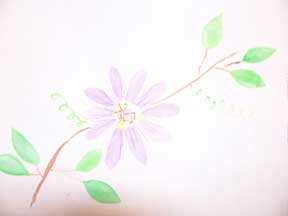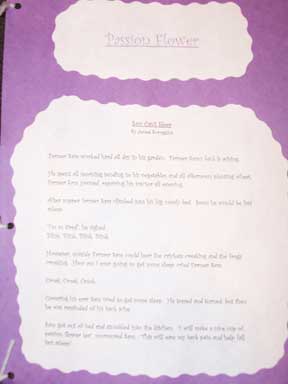Passion Flower
Family Name: Passion Flower
Family Name: Passifloraceae
Latin Name: Passiflora incarta
Common Names: Maypop, Passion vine, Purple passion flower, Apricot vine, Water
Lemon, Passiflore rouge, Passionsblume
Body System Affiliations:
1) Nervous System 
2) Respiratory System
3) Cardio-vascular System
4) First Aid
5) Skin
Botanical Description:
Habit: Flower, Vine – Perennial root and Annual tendrils
Size: Up to 30 feet (1)
Arrangement:
Leaves: Dull green, 4-6”, divided into 3-5 lobes, serrated edges. (1)
Flowers: White flowers tinged with purple and 2-3” across. They are a sweet-scented flower and bloom from June to August. (1)
Fruit: Egg size yellow and orange edible fruit. (1)
Underground Parts:
Ecology:
Habitat: Sandy thickets, open fields, roadsides, fence rows. (2)
Range: Eastern N. America, Virginia and Kentucky to South Florida and Texas.
Native Where: Eastern N. America native perennial vine (2)
Ecological Relationships:
Western (European-American) Uses/Relationships:
Food: The fruit and flowers can be eaten raw or cooked in jellies and jams.
Young leaves can be used as a cooked vegetable or eaten in salads.
Materials/Technology:
Medicine:
Part Used: Flowers and Leaves (3)
Medicinal Actions: Antispasmodic, Sedative, Anodyne, Nervine
Indications: Neuralgia, seizures, hysteria, nervous tachycardia,
spasmodic asthma, stress and insomnia. (3)
Body System Associations: Nervous system, Respiratory system,
Cardio-Vascular system. (3)
Constituents: Alkaloids- hazmine and flavonoids. (3)
Applications: First aid- crush leaves onto cuts. (3)
Tea- 1 teaspoon of dried leaves per cup of boiling water,
steep 15 minutes.
Tincture- Fresh (1:2), dry (1:5) 50% alcohol. ½ to 1 ½
teaspoons up to 3 times daily.
Infusion: 2.5 grams has been used 3 to 4 times daily
Dried herb: 0.5 to 2 grams taken 3 to 4 times daily
Cautions: Passion Flower should not be given to children under 2 years
old.
Side effects may include- Nausea, vomiting, drowsiness, rapid
heartbeat.
Indigenous and Non-Western Use/Significance/Relationships: The Houma, Cherokee along with other Native American tribes have used purple passion flower in various ways for a variety of uses. (4)
Food: Tea/Food. The fruits of this plant were eaten raw, boiled to make syrup, or
crushed into juice. Young leaves were eaten raw or cooked.
Medicine: The roots were used as an infusion to treat boils and other wounds.
Indigenous Group: Native Americans
Part Used: Roots, Flowers, Leaves
Medicinal Actions: First Aid, Sedative, Nervous System
Preparation: The roots were boiled into an infusion and then applied to
wounds. Roots were also made into a tea to sooth ailing infants. Roots
were also soaked in the drinking water and then used as a sedative.
Application: Tea, infusion, dried herb.
Pharmacy: None found
Cautions: None found
Propagation:
Technique: Cuttings should be 3-4 inches long and taken just beneath a leaf. Place cuttings in 3 inch pots and apply moisture evenly. Cover the entire pot with plastic and place in good but not direct sunlight. It will take three to four weeks before these cuttings will root. (4)
Timing: Late spring or early summer.
Harvest:
Plant Parts: Flowers and leaves (1)
Season of Harvest: July-October (1)
Method of Harvest: The aerial parts
Ecological Consideration of Harvest: Be aware of the plants surroundings (roadside) and be considerate of the amount you harvest.
Cultural Consideration of Harvest:
Cautions:
Personal Experience:
Food: I made tea
Medicine-
Part Used: Flowers and leaves
Desired Medicinal Actions: I used this tea to help me sleep.
Targeted Indications: Insomnia
Storage: I stored the flower/leaf mix in a glass jar.
Procurement-
Source: Radiance, Oly, Wa.
Condition: Dried
Cost: $.72
Application/Preparation/Pharmacy:
Applications: Tea
Preparation: The first time I made this tea I poured one teaspoon of mixed
flowers/leaves into my tea pot and brought to a boil. I strained and covered my
cup for approximately 10 minutes. The second time I made the tea I boiled water and then poured the water over the flower/leaf mix. I let steep for approximately 10 minutes. I didn’t care for the second batch of tea as much, so I went back to my original method.
Pharmacy: Tea made from 4 to 8 grams of dried mix can be taken daily.
Reason/Purpose: To help me relax and sleep.
Experience: I made the tea on three different occasions. I
enjoyed the taste, especially with a bit of sugar or honey. I also
enjoyed the relaxation it brought me and it’s aroma.
Cautions: Based on my experience I have not found any.
Sources:
- Plyer, Sheri & Charlie. Indian Spring Herbal Encyclopedia. 2001-2005. Online
at http://indianspringherbs.com/PassionFlower.htm. Visited 02/07/06.
- Bergeron, Karen. Alternative Nature Herbals. Online at http://altnature.com/gallery/passionflower.htm Constantly updated. Visited 02/08/06.
- Author Unknown. University of Maryland Medical Center. Online at http://www.umm.edu/altmed/ConsHerbs/Passionflowerch.html. Constantly updated. Visited 02/08/06.
- USDA, NRCS, National Plant Data Base. Plant Guide. Online at http://plants.usda.gov/java/profile?symbol=PALU2. Visited 02/11/06.
Jeneé Scroggins Arts, Environment and The Child Winter 2006
Plant Narrative
Passion flower is a perennial vine native to Eastern North America. It has a perennial root and annual tendrils. This flower can be located in sandy thickets, open fields, fence rows, or roadsides. The flower can range from pale lavender or white with about five petals. This flower also has a corona which displays elaborate fringelike segments that rise above the petals. The color of the corona is white, or lavender with purple bands. The leaves are palmate and have finely serrated edges. Passion flower blooms from June to September and flourishes with sweet smelling fruit about two to three months after flowering. The fruit and flowers can be eaten raw, cooked in jellies or jams, or tossed into a salad.
The flowers and leaves are used to help relieve certain medical ailments. Passion flower’s main medicinal properties include: Sedative, Nervine, Antispasmodic and Anodyne. This flower can help aid the following body systems: nervous system, Respiratory system, cardio-vascular system and skin. It can help relieve pain, calm nerves and relieve sleeplessness.
It has been reported that this flower has been used for hundreds of years by the Houma, Cherokee and other Native Americans. The fruits were used to make syrup and juice. The roots, flowers and leaves were also used to treat certain wounds.
Passion flower, because of its unique appearance has also been depicted to represent the suffering of Christ. “The name Passion Flower refers to Christ: the 3 stamens represent his wounds, and the 12 petals represent the apostles.” (2)
________________________________________________________________________________________________
Child Friendly Version
Sam Can't Sleep
By Jeneé Scroggins
Farmer Sam worked hard all day in his garden. Farmer Sam's back is aching.
He spent all morning tending to his vegetables and all afternoon planting wheat.
Farmer Sam yawned, repairing his tractor all evening.
After supper farmer Sam climbed into his big comfy bed. Soon he would be fast asleep.
"I'm so tired", he sighed.
Blink, Blink, Blink, Blink.
However, outside Farmer Sam could hear the crickets creaking and the frogs croaking. How am I ever going to get
some sleep cried Farmer Sam.
Croak, Croak, Croak..
Covering his ears Sam tried to get some sleep. He tossed and turned, but then he was reminded of his back ache.
Sam got out of bed and stumbled into the kitchen. "I will make a nice cup of passion flower tea", murmured
Sam. "This will ease my back pain and help fall fast asleep".

